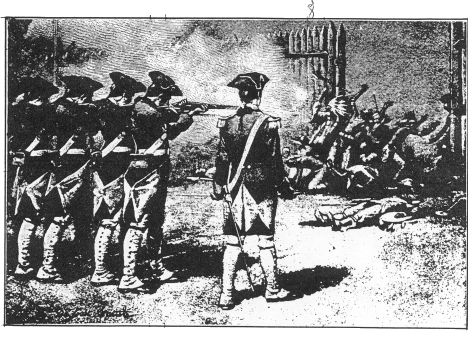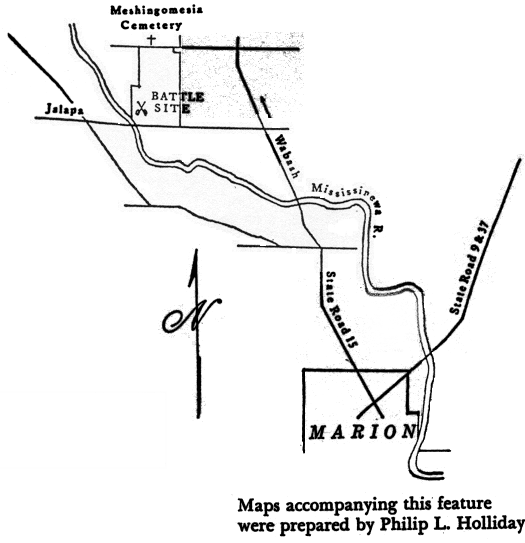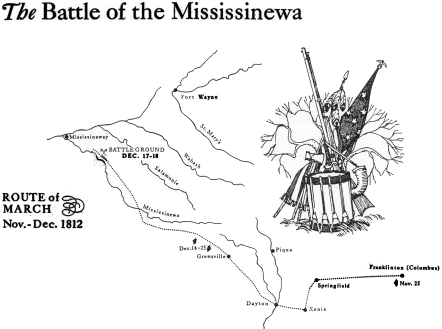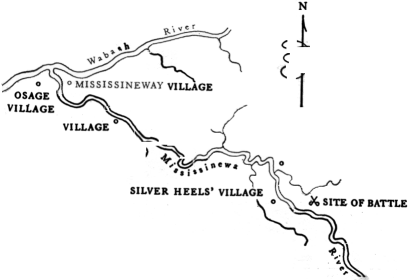

The battle of the Mississinewa was a part of the War of 1812. It was the last battle fought in what is now Indiana, and it was also the last time that the Miami fought as a nation. The battle site was on the right bank of the Mississinewa about a mile east of the present village of Jalapa and seven miles northwest of Marion. Anti-Indian feeling ran high in the West, and the War of 1812 received universal support from the Americans who felt that British influence and money were responsible for much of the Indian troubles and who were impatient to expand the frontier into Indiana territory. Young men in Kentucky, Ohio, Pennsylvania and the Michigan Territory eagerly joined volunteer units of cavalry and infantry. Enlisted for periods of from six to twelve months; these volunteer companies were locally equipped, drilled and officered. The United States Army, which consisted of only twelve regiments in January, 1812, was heavily dependent upon them. Some of the volunteer units, like the Pittsburgh Blues, were as well trained and equipped as the regular army. These men, mostly between the ages of sixteen and twenty-two, generally knew each other, many were related to each other, and they had pride and confidence in their officers who, in most instances, were the recruiters. The soldiers of the Mississineway expedition were paid five dollars a month for their services and twelve dollars for the use of the horses, a clear indication that monetary reward was not the principal motive for their service. The war was declared in June, and at the beginning things went very badly for the Americans. By the middle of August the forts at Mackinac and Dearborn had fallen, and General Hull had surrendered his entire army at Detroit without resistance. The Indians who massacred the garrison at Fort Dearborn were joined by others, many of whom were Miami, and laid seige to Fort Wayne early in September.General William Henry Harrison, who had been sent word of the seige, marched from Fort Washington (Cincinnati) with an army of 2200 and dispersed the Indians without a battle. Harrison then proceeded to lay waste to the Miami villages north and west of Fort Wayne and at the junction of the Wabash and Little rivers near the present city of Huntington. The village of Mississineway lay just thirty miles to the south of this last place; but Harrison apparently considered it of no importance at this time, as the army returned to Ohio without venturing further. The village of Mississineway had been founded early in the summer of 1795 at the junction of the Mississinewa and Wabash rivers by the Miami Peshewah (John B. Richardville) as a place for this people to go when Fort Wayne was built on their former village site on the Maumee. It was to Mississineway that the rest of the Miami fled when their villages and crops to the north were destroyed by Harrison. Their remaining food for the winter was in this area; and it held some promise of safety, as it was removed from the path of the army on its way to Canada. In spite of the knowledge that the surviving Miami were in distress and without military leadership, General Harrison concluded in November that the concentration at Mississineway constituted a threat to him, and he organized an expedition to destroy it. The expedition for Mississineway was composed of more than six hundred men, and it began to assemble at Franklinton (Columbus, Ohio) on November 5, 1812. The army consisted of Major James V. Ball's Squadron composed of the 2nd Regiment of U.S. Light Dragoons and volunteer companies from Kentucky, Ohio, Pennsylvania and Michigan; Colonel James Simrall's Regiment of Kentucky Volunteer Light Dragoons; Captain Alexander's Pennsylvania Riflemen; the Pittsburgh Blues; the 19th Regiment of U.S. Infantry; and a group of spies and guides, in addition to the staff officers. The senior officers and staff officers of the command were experienced and knew what to expect from their men; but the commanding officer, Lieut Colonel John B. Campbell, had been commissioned on joining the army a few months before and was without military experience of any kind. Campbell received his orders and the army left Franklinton on November 25th, proceeding through Springfield to Xenia where the troops were mustered in and paid. On December 5th the expedition left Xenia and marched into Dayton. In Dayton horses were provided the infantrymen, muskets were exchanged for Yaugers (short rifles) and cavalry arms, and the army dispossessed itself of its tents and all baggage not essential to light travel. Provisions were issued consisting of biscuits and pork. The troops proceeded through Lexington and were advised of their destination and the object of the expedition just prior to entering Greenville on December 13th. Greenville was on the edge of the wilderness, and few men knew their way westward. Guides had been provided who had engaged in trading with the Indians and were to some extent acquainted with travel in the forest. The weather was extremely cold; the snow was deep, and the swamps and streams were frozen. These conditions were considered to be ideal for the expedition, but they were also to be the cause of much suffering and near disaster. As they entered the wilderness, each man carried his own provisions consisting of biscuits, pork, and one bushel of corn, thought sufficient to last twelve days. On the first day out of Greenville the army traveled fifteen miles through the wilderness; and on the second day, twenty miles. On the third day, the troops marched all day and, with a brief rest for supper, marched all through the night. They crossed the Mississinewa River near the present town of Eaton and arrived with sight of the first Indian village shortly after dawn on December 17th. This village, to become the site of the engagement of the next day, was located on the right bank of the Mississinewa, seventeen miles above the village of Mississineway, which was the first objective of the expedition. The dragoons, probably due to fatigue, entered the village in great disorder. Some missed it completely, and in the confusion caused the death of one of their own men. Eight Indians were killed and forty-two prisoners taken. These prisoners, all Munsees, were the only ones taken by the expedition. They were housed in two of the huts, and the remainder of the village was burned. The infantry remained with the prisoners, and the dragoons pursued the escaping Indians down the river and destroyed two more villages enroute. One of the villages was that of the Miami Chief Metocinyah at the mouth of Jocinah Creek. No resistance was encountered as the occupants of these villages fled in advance of the troops. The dragoons returned to the site of the first village where a camp five hundred feet square had been laid out with redoubts on its northern side. The army settled down for the night with a strong guard posted. The prisoners were interrogated and said that there was a large number of warriors assembled at the village of Mississineway. The expedition's food supply was becoming critical, and frostbite was clearly a very serious problem. Weighing these matters, Campbell called the senior officers to his campfire before dawn to consider an immediate return to Greenville. However, before this conference was concluded, the Indians attacked. The redoubt at the northwest corner of the encampment was overwhelmed, and a heavy fire was poured on the troops of Hopkins and Garrard of Ball's Squadron. Major Ball called for assistance, and Campbell sent the Pittsburgh Blues too relieve the pressure on the northwest corner. The Blues, firing by platoons, were most effective, and the attack shifted south along the west side of the camp. The battle proper was of about an hour's duration. At dawn the fire of the troops became more accurate, and it was apparent to the Indians that the strength of the army was too much for them. As the Indians broke off the attack and retreated down river, Campbell sent Simrall's men in pursuit. Upon their return they reported that the Indians had indeed departed and that there was no immediate danger from them. The dead were buried, and the huts where the prisoners were kept were pulled down on the graves and burned to prevent the discovery of the burial place. This precaution was not taken at the Battle of Tippecanoe, and the dead were exhumed and scalped by the Indians, only to be buried again by General Hopkin's men. The Indians dug up the bodies a second time and they were not properly interred for ten years. With the wounded in litters and the prisoners in tow, the expedition left the battleground late in the afternoon on their return to Greenville. Over a hundred horses had been killed in the battle, and their loss made progress more difficult. The remaining horses were much weakened, as they were accustomed to regular feeding of grain and hay and were unable to subsist in the forest in winter. The night of December 18th was spent just two miles from the battleground. During the next three days only thirty-seven miles were traveled. Because the army expected an attack at any time, much time and energy were actually wasted each night cutting trees, with the few axes at hand, to provide protection. Campbell had sent three men ahead to request reinforcements and provisions. These men traveled the nearly eighty miles to Greenville in the astonishing time of twenty-two hours and were responsible for the expedition meeting Major John Adair with reinforcements on December 22nd. Adair had food with him for the trip out; and there was enough for each of Campbell's men, most of whom had had nothing to eat for days, to have a half ration per man. The next day another detachment was met carrying enough supplies to enable the exhausted troops to enter Greenville on December 24th. The horses were in a pitiful condition, thirteen men had been killed, forty-four were wounded, and more than three hundred were suffering seriously from frostbite with many facing amputation. No one knows how many Indians were engaged or who led their attack. A guide, William Conner, thought he heard the voice of Little Thunder, a nephew of Little Turtle. Meshingomesia always claimed that he did not participate - a sound position to take later when dealing with Indian agents. The warrior chiefs were dead, and leadership has passed to Richardville and other sons of French fathers - men not inclined to fight but to enrich themselves and who did so later by dealing with the Americans and often at the expense of their own people. Most of the young, belligerent braves had gone north to join Tecumseh, and those at Mississinewa were desperate men fighting to protect their families from the incursion of the Americans. It was not an accident that more than a hundred horses belonging to the American troops were killed. For the Indians to accomplish their purpose, it was not necessary to destroy the troops of Campbell, but only to check their progress, cause them to return and leave the villages unmolested. Although, within a week after the return of the expedition, General Harrison was consulting with Governor Meiggs of Ohio to raise another force for the destruction of Mississineway, the Miami were left unmolested throughout the winter. In the spring they evacuated their villages and the following July the empty villages were destroyed by Colonel William Russell. Most of the troops were unfit for further service on their return to Greenville, and many of the enlistment periods were about to expire. Colonel Simrall had to recruit a new regiment and nearly all of the units engaged had to be reformed. Only the extravagant prose of the military commander of the day could have turned the affair into a victory, and Harrison was equal to the occasion. His reports received the approval of the President of the United States, and a full colonel's commission was obtained for Campbell in addition to several raises in rank for many of the regular army officers. After the war many of the men who participated in the battle at Mississinewa played prominent parts in the development of the state of Indiana. Among them were William Conner, one of the guides, who became a founder of Noblesville; Captain Markle, of Ball's squadron, who was granted land on the Wabash and was one of the founders of Terre Haute; and First Sergeant Thomas W. Porter, of McClelland's company, the father of Indiana's Governor Albert G. Porter. (Article from - image/March 1968 by Murray Holliday)


